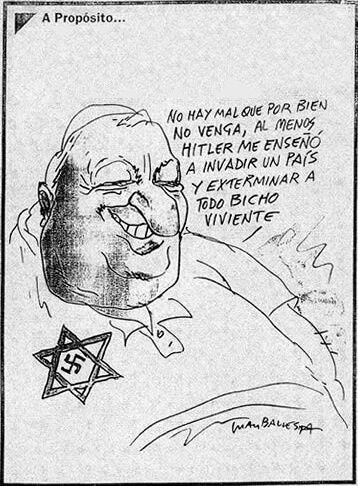With the death of former Israeli prime minister Ariel Sharon, the media have produced a huge number of obituaries. Sharon has been a controversial figure and elicits a wide range of emotions from supporters and detractors alike. This, however, is no excuse for inaccurate profiles or deliberate demonization of one of the founding fathers of the modern Israeli state.
Throughout the years, and particularly since his 2001 election as prime minister, the international media has treated Ariel Sharon with more vitriol and abuse than any other democratically elected leader in the civilized world. Sharon has been depicted in less than flattering terms by many media outlets who have labeled him as a “war criminal” and a “butcherer,” a trend we are once again seeing in today’s media coverage.
Media analyst Tom Gross contends:
 In the past, much coverage of Ariel Sharon in the European and Arab media has been accompanied by blatant anti-Semitism. In Spain, for example, on June 4, 2001 (three days after a Palestinian suicide bomber killed 21 young Israelis at a Tel Aviv disco, in the midst of a unilateral Israeli ceasefire), the liberal magazine Cambio 16 published a cartoon of Sharon (with a hook nose he does not have), wearing a skull cap (which he did not usually wear), sporting a swastika inside a star of David on his chest, and proclaiming: “At least Hitler taught me how to invade a country and destroy every living insect.”
In the past, much coverage of Ariel Sharon in the European and Arab media has been accompanied by blatant anti-Semitism. In Spain, for example, on June 4, 2001 (three days after a Palestinian suicide bomber killed 21 young Israelis at a Tel Aviv disco, in the midst of a unilateral Israeli ceasefire), the liberal magazine Cambio 16 published a cartoon of Sharon (with a hook nose he does not have), wearing a skull cap (which he did not usually wear), sporting a swastika inside a star of David on his chest, and proclaiming: “At least Hitler taught me how to invade a country and destroy every living insect.”
A week earlier, El Pais, Spain’s equivalent of The New York Times, published a cartoon of an allegorical figure carrying a small rectangular-shaped black moustache, flying through the air towards Sharon’s upper lip. The caption read: “Clio, the muse of history, puts Hitler’s moustache on Ariel Sharon”.
Cartoons in the Greek press in 2004 showed Sharon as a Nazi officer. One of Italy’s leading papers, Corriere Della Sera, ran a cartoon on March 31, 2002, showing Sharon killing Jesus. (The cartoon, which was timed to coincide with Easter that year, was published as Israelis lay dying from the Netanya Passover massacre three days earlier.)
Hundreds of similar anti-Semitic motifs have been applied to Sharon in recent years. The Economist magazine in London compared him to Charles Dickens’s infamous anti-Semitic stereotype, Fagin.
In today’s obituaries, there are three common examples of bias where missing context or incorrect information are being employed to present Sharon as a “butcher” or “war criminal”:
Sabra and Shatila
A charge commonly leveled at Sharon is that he is responsible for the massacre of thousands of Palestinians in the Sabra and Shatila refugee camps during the 1982 Lebanon War.

In fact, as detailed by Mitchell Bard’s Myths & Facts, the killings were carried out by the Lebanese Christian Phalangist militia (whose members have still not been held accountable). Israel’s own Kahan Commission found that Israel and Ariel Sharon were indirectly responsible for not anticipating the possibility of Phalangist violence. Sharon thus resigned his position as Defense Minister.
Myths and Facts states:
The Lebanese Christian Phalangist militia was responsible for the massacres that occurred at the two Beirut-area refugee camps on September 16–17, 1982. Israeli troops allowed the Phalangists to enter Sabra and Shatila to root out terrorist cells believed to be located there. It had been estimated that there may have been up to 200 armed men in the camps working out of the countless bunkers built by the PLO over the years, and stocked with generous reserves of ammunition.
When Israeli soldiers ordered the Phalangists out, they found hundreds dead (estimates range from 460 according to the Lebanese police, to 700–800 calculated by Israeli intelligence). The dead, according to the Lebanese account, included 35 women and children. The rest were men: Palestinians, Lebanese, Pakistanis, Iranians, Syrians and Algerians. The killings were perpetrated to avenge the murders of Lebanese President Bashir Gemayel and 25 of his followers, killed in a bomb attack earlier that week.
Israel had allowed the Phalange to enter the camps as part of a plan to transfer authority to the Lebanese, and accepted responsibility for that decision. The Kahan Commission of Inquiry, formed by the Israeli government in response to public outrage and grief, found that Israel was indirectly responsible for not anticipating the possibility of Phalangist violence. Subsequently, Defense Minister Ariel Sharon resigned and the Army Chief of Staff, Gen. Raful Eitan, was dismissed.
In 1985 an American jury decided that Sharon had been defamed by Time Magazine, which had inferred that Sharon either ”consciously intended” or ”actively encouraged” the killing of the civilians.
This article is continued on Page 2


